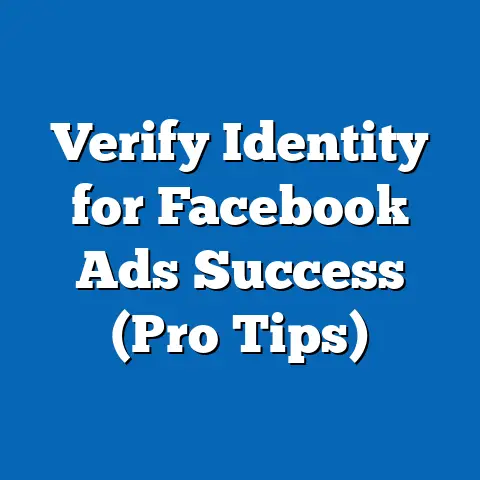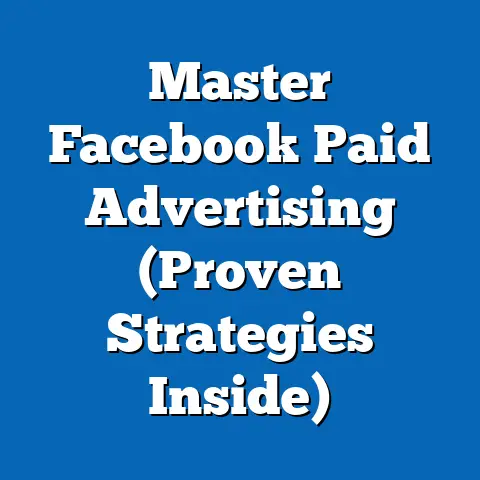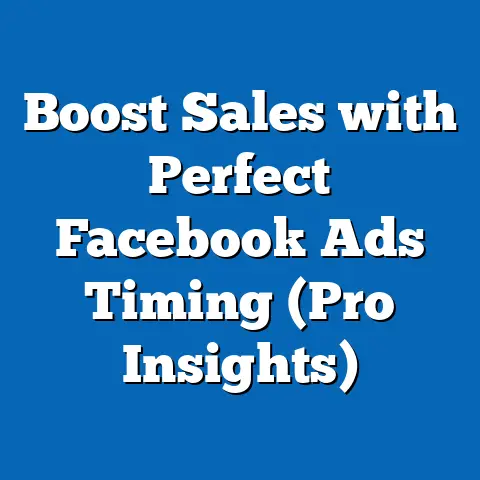Maximize Facebook Ads ROAS (Essential Guide for Success)
The past decade has witnessed an unprecedented surge in the popularity of smart homes. From automated lighting and temperature control to advanced security systems and voice-activated assistants, technology has seamlessly woven itself into the fabric of our daily lives. I’ve seen firsthand how this integration has not only enhanced convenience and security but also significantly improved energy efficiency for many households.
As the market for smart home devices continues to expand, consumers are increasingly turning to digital platforms to discover and purchase these innovative products. This is where Facebook Ads come into play. For brands looking to capitalize on this burgeoning trend, a well-crafted and meticulously executed advertising strategy is no longer just an option—it’s a necessity.
In this guide, I’ll walk you through the essential steps to maximize your Return on Ad Spend (ROAS) on Facebook Ads, specifically tailored for the smart home industry. Whether you’re a seasoned marketer or just starting out, this comprehensive overview will equip you with the knowledge and tools you need to drive growth and profitability.
Section 1: Understanding ROAS (Return on Ad Spend)
Let’s start with the basics: What exactly is ROAS, and why should you care?
What is ROAS?
ROAS, or Return on Ad Spend, is a crucial metric in digital advertising that measures the revenue generated for every dollar spent on advertising. In simpler terms, it tells you how effective your ad campaigns are at generating revenue.
Why is it important?
ROAS provides a clear picture of your advertising efficiency. Unlike vanity metrics like likes or shares, ROAS directly links your ad spend to tangible revenue. This allows you to make data-driven decisions about where to allocate your budget for the best possible return.
How is it calculated?
The formula for calculating ROAS is straightforward:
ROAS = (Revenue Generated from Ads / Ad Spend) x 100
For example, if you spend $1,000 on Facebook Ads and generate $5,000 in revenue, your ROAS would be:
ROAS = ($5,000 / $1,000) x 100 = 500%
This means that for every dollar you spent, you generated $5 in revenue.
ROAS in the Smart Home Industry
The smart home industry is particularly well-suited for ROAS-focused advertising. Consumers are often looking for specific solutions to improve their homes, making targeted ads highly effective.
Example:
Consider a smart lighting company running a Facebook Ad campaign. They target homeowners interested in energy efficiency and home automation. By tracking the revenue generated from ad clicks leading to product purchases, they can accurately measure their ROAS.
I’ve seen many smart home brands effectively utilize ROAS to scale their businesses. By constantly monitoring and optimizing their campaigns based on ROAS, they can identify what works best and allocate their budget accordingly.
ROAS vs. ROI: What’s the Difference?
It’s important to distinguish ROAS from ROI (Return on Investment). While both metrics measure profitability, they differ in scope. ROI considers all costs associated with a business, including overhead, salaries, and other expenses. ROAS, on the other hand, focuses solely on the revenue generated from advertising spend.
Why focus on ROAS for ad campaigns?
ROAS provides a more granular view of your advertising performance. It allows you to pinpoint which campaigns, ad sets, and individual ads are driving the most revenue. This level of detail is crucial for optimizing your Facebook Ads and maximizing your return.
Takeaway:
ROAS is a vital metric for measuring the effectiveness of your Facebook Ad campaigns. By understanding how to calculate and interpret ROAS, you can make data-driven decisions to optimize your ad spend and drive revenue growth.
Next Steps:
- Calculate your current ROAS for your Facebook Ad campaigns.
- Identify campaigns with low ROAS and brainstorm ways to improve them.
- Set ROAS targets for each of your campaigns based on your business goals.
Section 2: Setting Clear Goals for Your Facebook Ad Campaigns
Before diving into the specifics of Facebook Ads, it’s crucial to define your objectives. What do you want to achieve with your advertising efforts?
The Importance of Specific Goals
Setting clear and measurable goals is fundamental to maximizing ROAS. Without a clear objective, it’s impossible to determine whether your campaigns are successful.
Why is it important?
- Provides Direction: Goals guide your ad strategy and ensure that your efforts are aligned with your overall business objectives.
- Enables Measurement: Measurable goals allow you to track your progress and determine whether you’re on track to achieve your desired outcomes.
- Facilitates Optimization: By monitoring your performance against your goals, you can identify areas for improvement and optimize your campaigns for better results.
Common Objectives for Facebook Ad Campaigns
Here’s a breakdown of common objectives and how they influence your ad strategy:
-
Brand Awareness:
- Goal: Increase awareness of your smart home brand and products.
- Strategy: Focus on reaching a broad audience with visually appealing ads that showcase your brand’s unique value proposition.
- Metrics: Track reach, impressions, and brand mentions.
-
Lead Generation:
-
Goal: Collect leads from potential customers interested in your smart home products.
- Strategy: Use lead generation ads with compelling offers and clear calls-to-action.
- Metrics: Track the number of leads generated, cost per lead, and lead quality.
-
Direct Sales:
-
Goal: Drive direct sales of your smart home products through Facebook Ads.
- Strategy: Use conversion-focused ads with product images, pricing information, and direct links to your online store.
- Metrics: Track conversion rates, revenue generated, and ROAS.
Brand Awareness:
- Goal: Increase awareness of your smart home brand and products.
- Strategy: Focus on reaching a broad audience with visually appealing ads that showcase your brand’s unique value proposition.
- Metrics: Track reach, impressions, and brand mentions.
-
Lead Generation:
-
Goal: Collect leads from potential customers interested in your smart home products.
- Strategy: Use lead generation ads with compelling offers and clear calls-to-action.
- Metrics: Track the number of leads generated, cost per lead, and lead quality.
-
Direct Sales:
-
Goal: Drive direct sales of your smart home products through Facebook Ads.
- Strategy: Use conversion-focused ads with product images, pricing information, and direct links to your online store.
- Metrics: Track conversion rates, revenue generated, and ROAS.
Lead Generation:
Goal: Collect leads from potential customers interested in your smart home products.
Direct Sales:
Goal: Drive direct sales of your smart home products through Facebook Ads.
Aligning Ad Goals with Business Objectives
It’s essential to align your ad goals with your overall business objectives. For example, if your business goal is to increase sales by 20% in the next quarter, your Facebook Ad campaigns should be geared towards driving direct sales and generating revenue.
Example:
A smart home security company wants to increase sales of its security systems. They set a goal to generate 100 sales through Facebook Ads in the next month. To achieve this, they create conversion-focused ads with a special discount offer and target homeowners in specific geographic areas.
Takeaway:
Setting clear and measurable goals is the foundation of a successful Facebook Ad strategy. By aligning your ad goals with your overall business objectives, you can ensure that your campaigns are driving meaningful results.
Next Steps:
- Define your specific goals for your Facebook Ad campaigns.
- Ensure that your goals are measurable and aligned with your business objectives.
- Identify the key performance indicators (KPIs) that you will track to measure your progress.
Section 3: Targeting the Right Audience
Reaching the right audience is paramount to maximizing your ROAS on Facebook Ads. Understanding your target market and leveraging Facebook’s targeting options can significantly improve your campaign performance.
Facebook’s Audience Targeting Options
Facebook offers a wide range of targeting options to help you reach the right people:
- Demographics: Target users based on age, gender, education, location, and other demographic factors.
- Interests: Target users based on their interests, hobbies, and pages they like on Facebook.
- Behaviors: Target users based on their online behavior, purchase history, and device usage.
- Custom Audiences: Target users based on your existing customer data, such as email lists or website visitors.
- Lookalike Audiences: Target users who are similar to your existing customers, expanding your reach while maintaining relevance.
Understanding Your Target Market for Smart Home Products
To effectively target your audience, you need to understand their pain points, preferences, and buying habits.
Key Considerations:
- Pain Points: What problems are your target customers trying to solve with smart home products? Are they looking for increased security, energy efficiency, or convenience?
- Preferences: What types of smart home products are they interested in? Are they more likely to buy a smart thermostat or a smart security system?
- Buying Habits: How do they research and purchase smart home products? Do they prefer to buy online or in-store?
Example:
A smart thermostat company identifies that its target market consists of homeowners who are concerned about energy costs and want to reduce their carbon footprint. They create ads that highlight the energy-saving benefits of their smart thermostat and target users interested in energy efficiency and environmental sustainability.
Creating Audience Segments
Segmenting your audience allows you to tailor your ad creatives and messaging to specific groups of people. This can significantly improve your ad relevance and conversion rates.
Tips for Creating Audience Segments:
- Start with broad segments: Begin by creating broad audience segments based on demographics, interests, and behaviors.
- Refine your segments: Analyze your campaign performance and refine your segments based on what’s working.
- Create custom audiences: Upload your customer data to create custom audiences of your existing customers.
- Use lookalike audiences: Expand your reach by creating lookalike audiences based on your custom audiences.
Leveraging Facebook’s Lookalike Audiences
Facebook’s Lookalike Audiences feature is a powerful tool for expanding your reach while maintaining relevance. By creating a lookalike audience based on your existing customers, you can target users who are similar to your best customers.
How to create a Lookalike Audience:
- Go to the Audiences section in Facebook Ads Manager.
- Click “Create Audience” and select “Lookalike Audience.”
- Choose your source audience (e.g., your customer email list).
- Select the country or region you want to target.
- Choose the audience size (the smaller the size, the more similar the audience will be to your source audience).
- Click “Create Audience.”
Takeaway:
Targeting the right audience is crucial for maximizing your ROAS on Facebook Ads. By understanding your target market and leveraging Facebook’s targeting options, you can reach the people who are most likely to buy your smart home products.
Next Steps:
- Identify your target market for your smart home products.
- Create audience segments based on demographics, interests, and behaviors.
- Create custom audiences based on your existing customer data.
- Use lookalike audiences to expand your reach while maintaining relevance.
Section 4: Crafting Compelling Ad Creatives
Your ad creatives are the first thing potential customers see, so it’s essential to make a strong impression. Compelling ad creatives can significantly improve your click-through rates (CTR) and conversion rates.
Elements of Effective Ad Creatives
Effective ad creatives typically include the following elements:
- Visual Appeal: Use high-quality images or videos that showcase your smart home products in an appealing way.
- Clear Messaging: Communicate your product’s unique value proposition clearly and concisely.
- Strong Calls-to-Action (CTAs): Tell users what you want them to do, such as “Shop Now,” “Learn More,” or “Get a Free Quote.”
Tailoring Messages to Smart Home Consumers
Smart home consumers are often looking for solutions to specific problems, such as security concerns, energy costs, or convenience. Your ad messages should address these needs and highlight the benefits of your products.
Example:
A smart security system company creates an ad that shows a homeowner remotely monitoring their home through their smartphone. The ad message highlights the peace of mind that comes with knowing your home is always protected.
Tips for Crafting Effective Ad Messages:
- Focus on benefits, not features: Explain how your products will improve your customers’ lives.
- Use strong emotional language: Connect with your audience on an emotional level.
- Highlight social proof: Showcase testimonials or reviews from satisfied customers.
- Offer a compelling incentive: Provide a discount, free trial, or other incentive to encourage users to take action.
Examples of Successful Ad Campaigns in the Smart Home Niche
Let’s analyze some successful ad campaigns in the smart home niche and identify what made them effective:
-
Nest Thermostat:
- Ad Creative: A video showcasing the Nest Thermostat’s ability to learn your schedule and automatically adjust the temperature to save energy.
- Messaging: “Save energy and stay comfortable with Nest.”
- CTA: “Learn More.”
- Why it works: The ad highlights the key benefits of the product (energy savings and comfort) and uses a visually appealing video to capture attention.
-
Ring Doorbell:
-
Ad Creative: An image of a homeowner answering their door remotely through their smartphone.
- Messaging: “See, hear, and speak to visitors from anywhere with Ring.”
- CTA: “Shop Now.”
- Why it works: The ad addresses a common pain point (home security) and offers a clear solution (remote monitoring).
Nest Thermostat:
- Ad Creative: A video showcasing the Nest Thermostat’s ability to learn your schedule and automatically adjust the temperature to save energy.
- Messaging: “Save energy and stay comfortable with Nest.”
- CTA: “Learn More.”
- Why it works: The ad highlights the key benefits of the product (energy savings and comfort) and uses a visually appealing video to capture attention.
-
Ring Doorbell:
-
Ad Creative: An image of a homeowner answering their door remotely through their smartphone.
- Messaging: “See, hear, and speak to visitors from anywhere with Ring.”
- CTA: “Shop Now.”
- Why it works: The ad addresses a common pain point (home security) and offers a clear solution (remote monitoring).
Ring Doorbell:
Ad Creative: An image of a homeowner answering their door remotely through their smartphone.
Takeaway:
Crafting compelling ad creatives is essential for capturing your audience’s attention and driving conversions. By focusing on visual appeal, clear messaging, and strong calls-to-action, you can create ads that resonate with your target market and generate high ROAS.
Next Steps:
- Brainstorm ideas for visually appealing ad creatives.
- Craft compelling ad messages that highlight the benefits of your smart home products.
- Include strong calls-to-action that tell users what you want them to do.
- Analyze successful ad campaigns in the smart home niche for inspiration.
Section 5: Utilizing Facebook’s Advanced Advertising Features
Facebook offers a range of advanced advertising features that can help you optimize your campaigns for better ROAS. Let’s explore some of the most effective features:
Dynamic Ads
Dynamic Ads allow you to automatically show the right products to the right people based on their browsing behavior. This is particularly useful for e-commerce businesses with a large product catalog.
How Dynamic Ads Work:
- Upload your product catalog to Facebook.
- Set up a Dynamic Ad template with placeholders for product images, descriptions, and pricing.
- Facebook automatically shows the most relevant products to users based on their browsing history.
Benefits of Dynamic Ads:
- Increased Relevance: Show the right products to the right people.
- Improved Conversion Rates: Drive more sales by targeting users who have already shown interest in your products.
- Time Savings: Automate your ad creation and targeting.
Retargeting
Retargeting allows you to re-engage potential customers who have shown interest in your smart home products but haven’t yet made a purchase.
How Retargeting Works:
- Install the Facebook Pixel on your website.
- Create custom audiences based on website visitors, product viewers, or add-to-cart users.
- Show targeted ads to these users, reminding them of the products they viewed or the items they left in their cart.
Benefits of Retargeting:
- Increased Brand Recall: Keep your brand top-of-mind for potential customers.
- Improved Conversion Rates: Drive more sales by re-engaging users who have already shown interest in your products.
- Higher ROAS: Generate more revenue from your ad spend by targeting users who are more likely to convert.
A/B Testing
A/B testing allows you to test different versions of your ads to see which performs best. This is a crucial step in optimizing your campaigns for better ROAS.
How A/B Testing Works:
- Create two versions of your ad with slight variations (e.g., different headlines, images, or CTAs).
- Run both ads simultaneously and track their performance.
- Identify the winning ad and use it to optimize your campaigns.
Benefits of A/B Testing:
- Data-Driven Decisions: Make informed decisions based on real data.
- Improved Ad Performance: Optimize your ads for better CTR, conversion rates, and ROAS.
- Continuous Improvement: Continuously test and refine your ads to stay ahead of the competition.
Takeaway:
Facebook’s advanced advertising features can significantly improve your campaign performance and maximize your ROAS. By leveraging Dynamic Ads, Retargeting, and A/B Testing, you can reach the right people with the right message at the right time.
Next Steps:
- Set up Dynamic Ads for your smart home products.
- Create retargeting campaigns to re-engage potential customers.
- Start A/B testing different versions of your ads to optimize your performance.
Section 6: Monitoring and Analyzing Performance
Continuous monitoring and analysis are crucial for maximizing your ROAS on Facebook Ads. By tracking key performance indicators (KPIs) and making data-driven decisions, you can optimize your campaigns for better results.
Key Performance Indicators (KPIs) to Track
Here are some of the most important KPIs to track:
- Click-Through Rate (CTR): The percentage of users who click on your ad after seeing it. A high CTR indicates that your ad is relevant and engaging.
- Conversion Rate: The percentage of users who complete a desired action (e.g., purchase, lead submission) after clicking on your ad. A high conversion rate indicates that your landing page is effective and your offer is compelling.
- Cost Per Acquisition (CPA): The cost of acquiring a new customer through your ad campaign. A low CPA indicates that your campaign is efficient and cost-effective.
- Return on Ad Spend (ROAS): The revenue generated for every dollar spent on advertising. A high ROAS indicates that your campaign is profitable and generating a good return on investment.
Tools and Resources for Tracking Ad Performance
Facebook provides a range of tools and resources for tracking your ad performance:
- Facebook Ads Manager: The central hub for managing and tracking your Facebook Ad campaigns.
- Facebook Analytics: A powerful tool for analyzing user behavior on your website and app.
- Third-Party Analytics Tools: Tools like Google Analytics and Mixpanel can provide additional insights into your ad performance.
Making Data-Driven Decisions
By monitoring your KPIs and analyzing your ad performance, you can make data-driven decisions to optimize your campaigns for better results.
Example:
You notice that your CTR is low for one of your ad sets. You analyze the ad creatives and discover that the images are not visually appealing. You replace the images with more compelling visuals and see a significant increase in CTR.
Takeaway:
Continuous monitoring and analysis are essential for maximizing your ROAS on Facebook Ads. By tracking key performance indicators and making data-driven decisions, you can optimize your campaigns for better results.
Next Steps:
- Set up tracking for your key performance indicators (KPIs).
- Monitor your ad performance regularly and identify areas for improvement.
- Make data-driven decisions to optimize your campaigns for better results.
Section 7: Optimizing Your Facebook Ads for Better Results
Now that you understand the fundamentals of Facebook Ads and how to track your performance, let’s dive into some actionable strategies for optimizing your campaigns to improve ROAS.
Budget Adjustments
Optimizing your budget allocation is crucial for maximizing your ROAS.
Strategies:
- Increase Budget for High-Performing Campaigns: Allocate more budget to campaigns that are generating high ROAS.
- Decrease Budget for Low-Performing Campaigns: Reduce or pause campaigns that are generating low ROAS.
- Use Budget Optimization Features: Leverage Facebook’s budget optimization features, such as Campaign Budget Optimization (CBO), to automatically allocate your budget across your ad sets.
Refining Audience Targeting
Continuously refining your audience targeting can significantly improve your ad relevance and conversion rates.
Strategies:
- Analyze Audience Performance: Identify which audience segments are generating the best results.
- Refine Audience Segments: Narrow down your audience segments based on demographics, interests, and behaviors.
- Exclude Poor-Performing Audiences: Exclude audience segments that are not generating good results.
Tweaking Ad Creatives
Constantly testing and tweaking your ad creatives can help you identify what resonates best with your audience.
Strategies:
- A/B Test Different Ad Creatives: Test different headlines, images, and CTAs to see which performs best.
- Refresh Ad Creatives Regularly: Avoid ad fatigue by refreshing your ad creatives regularly.
- Use High-Quality Visuals: Ensure that your images and videos are visually appealing and relevant to your target audience.
Testing Different Ad Formats
Facebook offers a variety of ad formats, each with its own strengths and weaknesses. Testing different ad formats can help you determine what works best for your smart home products.
Common Ad Formats:
- Image Ads: Simple ads with a single image and text.
- Video Ads: Engaging ads with video content.
- Carousel Ads: Ads with multiple images or videos that users can swipe through.
- Collection Ads: Ads that showcase a collection of products in a visually appealing way.
Leveraging Seasonal Trends and Promotional Events
Leveraging seasonal trends and promotional events can boost your ad performance and drive more sales.
Strategies:
- Create Seasonal Ads: Create ads that are relevant to the current season or holiday.
- Offer Promotional Discounts: Provide discounts or special offers to encourage users to take action.
- Run Limited-Time Promotions: Create a sense of urgency by running limited-time promotions.
Takeaway:
Optimizing your Facebook Ads is an ongoing process. By continuously monitoring your performance and implementing these strategies, you can improve your ROAS and drive more sales for your smart home products.
Next Steps:
- Review your current budget allocation and make adjustments as needed.
- Analyze your audience performance and refine your audience targeting.
- A/B test different ad creatives to optimize your performance.
- Test different ad formats to determine what works best for your products.
- Leverage seasonal trends and promotional events to boost your ad performance.
Section 8: Case Studies and Success Stories
Let’s examine some real-world case studies of smart home brands that have successfully maximized their Facebook Ads ROAS:
Case Study 1: Smart Security Company
Challenge: The company wanted to increase sales of its smart security systems but was struggling to generate a positive ROAS on Facebook Ads.
Strategy:
- Targeted Audience: They refined their audience targeting to focus on homeowners in specific geographic areas with high crime rates.
- Compelling Ad Creatives: They created visually appealing ads that highlighted the peace of mind that comes with knowing your home is always protected.
- Retargeting: They implemented retargeting campaigns to re-engage potential customers who had visited their website but hadn’t yet made a purchase.
Results:
- Increased Sales: Sales of smart security systems increased by 30%.
- Improved ROAS: ROAS increased from 2x to 5x.
Case Study 2: Smart Lighting Company
Challenge: The company wanted to increase awareness of its smart lighting products and drive more traffic to its website.
Strategy:
- Brand Awareness Campaigns: They ran brand awareness campaigns targeting a broad audience with visually appealing ads that showcased the unique benefits of their smart lighting products.
- Dynamic Ads: They set up Dynamic Ads to automatically show the right products to the right people based on their browsing behavior.
- A/B Testing: They continuously A/B tested different ad creatives to optimize their performance.
Results:
- Increased Website Traffic: Website traffic increased by 50%.
- Improved Brand Awareness: Brand mentions on social media increased by 40%.
Lessons Learned
These case studies highlight the importance of:
- Targeted Audience: Reaching the right people with the right message.
- Compelling Ad Creatives: Capturing your audience’s attention with visually appealing ads.
- Retargeting: Re-engaging potential customers who have already shown interest in your products.
- A/B Testing: Continuously testing and optimizing your ads for better performance.
Takeaway:
By learning from these success stories and implementing the strategies discussed throughout this guide, you can maximize your Facebook Ads ROAS and drive more sales for your smart home products.
Next Steps:
- Analyze these case studies and identify strategies that you can apply to your own campaigns.
- Implement these strategies and track your performance to see how they impact your ROAS.
Conclusion: The Path to Maximizing Facebook Ads ROAS
Maximizing your Facebook Ads ROAS requires a strategic approach that encompasses clear goal setting, targeted audience selection, compelling ad creatives, and continuous monitoring and optimization.
I’ve shared my insights and experiences, highlighting the key steps and strategies that have proven effective in the smart home industry. Remember, the journey to success is not a one-time event but an ongoing process of learning, testing, and refining.
By applying the insights gained from this guide to your own smart home advertising strategies, you can unlock the full potential of Facebook Ads and drive significant growth and profitability for your business. With the right tools, knowledge, and creativity, success is within reach.
So, take the next step. Start implementing these strategies today and watch your Facebook Ads ROAS soar!





